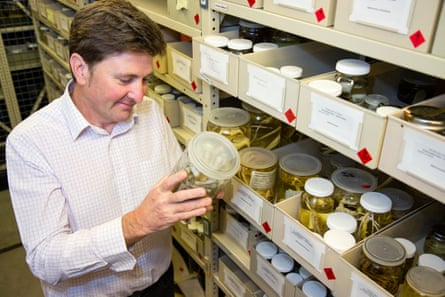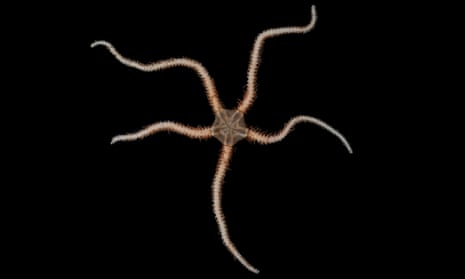Species as old as the dinosaurs are swimming around in tropical waters at depths accessed by commercial fishermen, according to a world-first study conducted by Australian researchers.
The study, published in the journal Nature on Thursday, examined data on brittle sea stars pulled from 1,500 research voyages in the southern hemisphere from the equator to Antarctica.
Brittle stars, five-legged alien-like creatures that make up the class Ophiuroidea, are abundant on the seafloor and make an “excellent model for studying patterns across all depths and latitudes,” researchers said.
The study identified a “museum zone” in the upper deep regions near the equator, where ancient species with a long lineage could be found alongside key commercial fishing species.
“The dinosaur-type things are all in the tropical deep sea … things that have just hung on for a long time and are on their last legs,” said lead researcher Dr Tim O’Hara, the senior curator of marine invertebrates at Museums Victoria.
“It’s not really an environment that’s being highlighted in conservation. People think of the need to conserve coral reefs, and that’s quite true, but equally we have to consider what are we doing to the depths between 200 and 800 metres.
“That’s where a lot of fisheries are, for example. And yet that’s where all these ancient animals, quite vulnerable animals, are living.”

Animals in the very deep ocean, dropping down to 4km below sea level, were much younger because they relied on the oxygen-rich cold water from the ice caps to be habitable.
“If the world is in a really hot time, like it was when the dinosaurs were around, there is no flow to the deep sea, the deep sea goes anoxic, and all of those animals are largely wiped out,” O’Hara said. “So there’s kind of this little sweet spot in the upper deep sea about 200 to 800 metres that seems to survive those sorts of environmental destructive climatic events.”
The study is the first published piece of research from a deep-sea expedition conducted by Museums Victoria and the CSIRO in 2017.
It examined 160,000 records of brittle stars, covering 596 species and 417 genera.
The animals, which O’Hara called “the garbage collectors of the sea,” are one of the few species that occur in abundance from the tropics to Antarctica. Some are small-scale scavengers, others are more predatory.
The stars showed that the freezing deep sea below Antarctica was an evolutionary hot spot, overturning previous assumptions that the cold temperatures had slowed the pace of change.
O’Hara attributed the “high speed” of diversification to the recent – in evolutionary terms – establishment of the ice caps, which have only been in place for 33 million years.
“Once the glaciers came and the ice caps formed it was so cold around that area that really the existing animals couldn’t cope and they largely died out, and a whole new fauna had to evolve,” he said. “Thirty-three million years later it’s still going gangbusters. It’s still recovering, in my view, from that extinction event.”
O’Hara said researchers now had enough data to re-construct the evolutionary history of the entire ocean and complete a global picture of evolutionary trends that began on land in the late 19th century – provided they can get the funding.
“People like comprehensive answers,” he said. “We want to tell the history of the oceans.”
